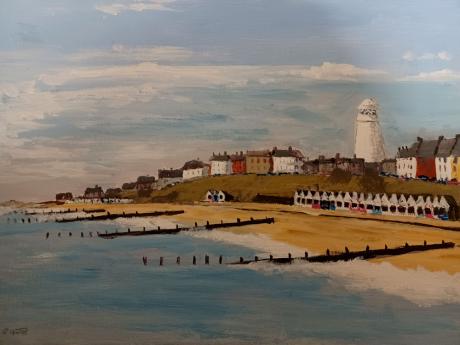"P Yates"
reproduced in "Paintings by Patricia Yates"
Southwold is described as the jewel of Suffolk's Heritage Coast, and it does not disappoint. With its famous pier, lighthouse and beach huts, Southwold is certainly one of the most popular resorts in East Anglia. Granted a Royal Charter back in 1489 by Henry VII. The centre piece is the magnificent church, with its 100 foot tower and dedicated to the last king of East Anglia, St Edmund. Nearby, the lighthouse, also 100 feet tall, has given safe passage to sailors and fishermen since 1890. However, much of Southwold's historic legacy relates to a famous sea battle fought off the coast in Sole Bay during the 17th century, when thousands of men were lost. This military theme is repeated on Gun Hill, where 6 cannons face out to sea and today they are a reminder of all those lost in battle. But Southwold is not just about the past. It is a great place to have fun and enjoy yourself, no matter what the weather is doing. For example, the pier has a fantastic collection of unique slot machines that is a must for every visitor to the town.
Southwold was mentioned in Domesday Book (1086) as a fishing port, and after the "capricious River Blyth withdrew from Dunwich in 1328, bringing trade to Southwold in the 15th century", it received its town charter from Henry VII in 1489. The grant of the charter is marked by the annual Trinity Fair, when it is read out by the Town Clerk. Over following centuries, however, a shingle bar built up across the harbour mouth, preventing the town from becoming a major Early Modern port: "The shingle at Southwold Harbour, the mouth of the Blyth, is ever shifting," William Whittaker observed in 1887.
Southwold was the home of a number of Puritan emigrants to the Massachusetts Bay Colony in the 1630s, notably a party of 18 assembled under Rev. Young, which travelled in the Mary Ann in 1637. Richard Ibrook, born in Southwold and a former bailiff of the town, emigrated to Hingham, Massachusetts, along with Rev. Peter Hobart, son of Edmund Hobart of Hingham, Norfolk. Rev. Hobart had been an assistant vicar of St Edmund's Church, Southwold, after graduating from Magdalene College, Cambridge. Hobart married in America Rebecca Ibrook, daughter of his fellow Puritan Richard Ibrook. The migrants to Hingham were led by Robert Peck, vicar of St Andrew's Church in Hingham and a native of Beccles.
A fire in 1659 devastated most of the town, creating spaces that were never built on again. Today this "series of varied and very delightful village greens" and the restriction of expansion by the surrounding marshes, have preserved the town's tidy appearance.
On the green just above the beach, descriptively named Gun Hill, six 18-pounder cannon commemorate the Battle of Sole Bay, fought in 1672 between English and French fleets on one side and the Dutch (under Michiel de Ruyter) on the other. The battle was bloody but indecisive and many bodies were washed ashore. Southwold Museum has a collection of mementos of the event. These cannon were captured from the Scots at Culloden and given to the town by the Duke of Cumberland, who had landed at Southwold in October 1745 having been recalled from Europe to deal with the Jacobite threat. In World War II they were prudently removed, reputedly buried for safety, and returned to their former position after hostilities.
On 15 May 1943, low-flying German fighter-bombers attacked the town and killed eleven people.
Southwold lighthouse was commissioned in 1890 and automated and electrified in 1938. It stands as a prominent landmark in the centre of the town and is a Grade II listed building. It is 31 metres (102 ft) metres tall, standing 37 metres (121 ft) metres above sea level. It is built of brick and painted white and has 113 steps around a spiral staircase.
The lighthouse replaced three local lighthouses that were under serious threat from coastal erosion. It suffered a fire in its original oil fired lamp just six days after commissioning but survived and today operates a rotating 150-watt lamp with a range of 24 nautical miles (44 km; 28 mi).

